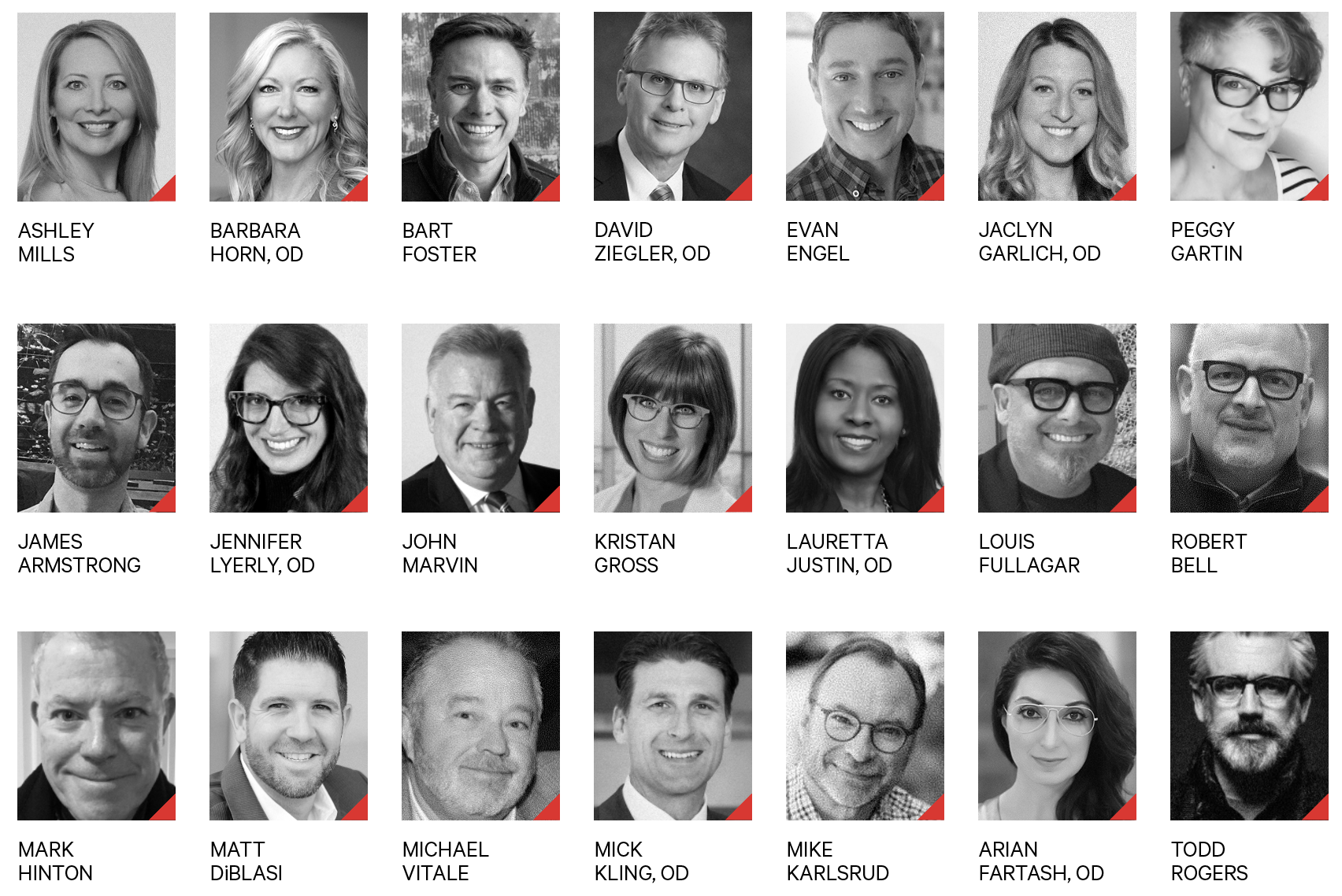The coming year has “eyecare” written all over it. But what changes can we expect to see in eyecare and eyewear as we enter a new year and a new decade? We asked more than 20 industry experts which major trends they expect to make themselves felt in the coming year and beyond. Their responses can make for scary reading at times — few independent ECPs leap for joy when they hear talk of “retail homogenization,” “online refraction” and “eroding margins.” But the way we see it, the real takeaway here is about silver linings and crises turned into opportunities. They say to be forewarned is to be forearmed. Check out the eight currents in the optical and optometric industry discussed in the following pages, and arm yourself for a new year—and a new era—in eyecare.

1. VERTICAL INTEGRATION
Among the industry experts INVISION spoke to for this article, the consensus is clear; the vertical integration that has been evident at all levels of the optical and optometry industry in recent years, from the Essilor/Luxottica merger to the private equity-fueled acquisition of independent practices, will only accelerate in 2020.
According to Evan Engel, vice president for sales and marketing at EyeCarePro, a digital marketing firm for eyecare businesses, “The financial incentive for the Essilors and VSPs of the world to own practices and push their products through their own practices will change the landscape, much like private pharmacies are virtually gone, replaced with CVS/Walgreens.” Mark Hinton, founder of advisory firm eYeFacilitate, puts a hard figure on the financial incentive described above by Engel, saying acquisitions can only grow as “venture capital execs will continue to show investors a 20-plus-percent gain” on acquisitions of eyecare practices.
Matt DiBlasi, president of Abyde, a HIPAA-compliance software provider, named the emergence of private equity within optometry as his top trend to watch. “It’s here and it’s here to stay,” he told us. “Will the independent OD thrive or eventually cave to the more recent trend of offloading business functions through the process of acquisition?”
The most obvious effect of this process is homogenization; as small businesses sell out to join large groups, eyecare is at risk of looking the same everywhere, something that, according to Jennifer Lyerly, OD, co-founder of Defocus Media, “weakens our chance to personally connect optometry’s message with patients.” As the current generation of eyecare’s most prominent leaders sells to private equity, she says, “We need to find and embrace new leaders in the profession who are innovating independent paths forward.”
According to business development expert Michael Karlsrud of the Karlsrud Company, the consolidation of the private ECP market will be focused on larger population areas, or where multiple office locations exist. This is significant, he says, as many frame and lens companies, along with their sales teams, are going to be at risk as decision-making and purchasing will become centralized to maximize purchasing power. “We may experience a loss of jobs in the overall market, and organizations will certainly have to regroup as their ‘A’ accounts are picked off.”
Advertisement
Other eyecare pundits are drawing similarly interesting conclusions. Richard Frankel, OD, of Atlantic Cape Eyecare in Wildwood, NJ, and founder of #emergingtrends on ODs on Facebook, says the acquisitions of VisionWorks by VSP, and FourEyes by Luxottica, point to “the growing segment of the eyecare market in the value-based segment as pioneered by America’s Best.” In addition, he says, “expect the VCPs [vision care plans] owned by those corporations to funnel more of their beneficiaries to them for added synergy.”
Louis Fullagar, creative director at SpexAddict, a digital marketing firm specializing in the eyewear industry, and founder of the online magazine Luxury Eyewear Forum, sees a lot of retirements on the horizon. This will in turn create a real opportunity for independents to separate themselves from the herd, he says. “I see growth in the area happening already but I think there will be more pressure to differentiate in the changing market profile over the next year. It will be ‘decision time’ for many owners to either sellout or step it up!”
Echoing this is Bart Foster, managing director of Colorado-based Sanitas Advisors, who says that while, sure, it can be a scary thing to see, the continued vertical integration of the industry can be an opportunity for those ECPs who recognize it, helping to open up space for smaller companies and niche brands.
James Armstrong of Alberta Eyecare in Portland, OR, made this bold call on an acquisition that’s barely three months old: “VSP abandons VisionWorks after massive revenue losses.”

2. TELE-OPTOMETRY HAS LANDED!
Industry observers have been warning for years that it’s just a matter of time until online refraction becomes something optometric practices will have to take seriously. Well, if our experts are to be believed, that time is upon us, with 2020, as Texas State Optical president John Marvin puts it, likely to be the year that “tele-optometry will go mainstream and be adopted by large groups.”
Advertisement
As far as telemedicine in general goes, Michael Kling, OD/owner at Invision Optometry in San Diego, CA, sees a familiar pattern. “It’s real and it’s coming. Not just to service the under-served, rural areas of the country, but also to meet the increasing demand for convenience and efficiency. Disruption occurs when a new market is created, first by appealing to a niche market, then by becoming mainstream. Just like we’ll soon be hailing driver-less automobiles to get to work, we’ll soon see a completely virtual healthcare delivery system emerge.” It’s an idea expressed succinctly by Peggy Gartin, founder/CEO of The Social Eye, a social media agency for optical businesses, who says that the pressure is on to make online exams a reality, “because some people just don’t want to go to the doctor.”
Foster of Sanitas Advisors not only agrees that the trend is real, he embraces it. “Telehealth — soon to be called just health — and online refractions will finally gain a foothold and enable eyecare providers to offer better access with fewer costs.
Karlsrud, while agreeing that acceptance of online exams is on the way, isn’t sold on the idea that 2020 will be the year US consumers fully buy in. “We are in the third inning of the ballgame. When online refraction becomes perfected and accepted overseas, it will be more accepted in the US. When that happens, look for the consumer to take more control of their healthcare and make decisions based on their own consumer ‘needs,’ i.e. fashion, flexibility, cost, utility measures, versus eye health and other benefits of a healthy eye exam.”
The question ECPs should be asking themselves, according to Lauretta Justin, OD, owner of Millennium Eye Center and founder of Optometry Divas in Orlando, FL, is no longer really about whether telemedicine is coming, or even how to incorporate it into their practices, but how to ensure it best serves eye health. “If we get involved and find ways to incorporate its use in our practices, I believe we can help steer it in the right direction,” she says. Lyerly takes a similar view. “We have to find a way to use it ethically or risk being left behind,” she says. “Primary care doctors are already using telemedicine to prescribe antibiotics for ‘pinkeye’ — even though we know most acute conjunctivitis is viral and doesn’t need antibiotics. Can we ethically employ telemedicine to meet the convenience our patients want, without sacrificing proper care and contributing to antibiotic resistances? If optometry can find the path forward that balances these concerns, our profession will be stronger for it. The pioneers that will bring us into the future are out there right now embracing the challenge.”

3. DECLINING ENROLLMENT, CORPORATE RECRUITMENT
One topic that our experts will be looking carefully at over the next year is the perhaps too-seldom discussed subject of the state of education for aspiring optometrists and opticians.
Advertisement
Sadly, Hinton expects opticianry colleges will continue to see a drop in enrollment as optical salaries present a lower income opportunity than other trades. As for ODs, graduates will flock towards corporate stores instead of private practice, says Karlsrud. “Their debt load will be very high and the risk too great not to seek the shelter of a larger organization — particularly in a market that is shifting rapidly,” he says, with the end result being less options for retiring doctors in smaller markets to have an exit strategy. “In the end, this could mean few choices for care in small markets, forcing the patients to drive to larger communities, or for the younger demographic to hit online options,” he adds.
EyeCoach’s Bell offered the glum prediction that schools and colleges of optometry “will continue to do a disservice to their students by not offering any classes in how to run/manage a profitable practice/business or making the following classes mandatory in undergraduate studies as a criteria in being accepted into optometry school: Entrepreneurship, Business Finance/Accounting, Sales & Marketing, Human Resources, Inventory Control, etc., etc., all the while as students accumulate crushing debt from their student loans which average around $200,000.” Because of this, he warns, independent optometry will see a further drop in capture rates and big box stores and online retailers will continue to see growth “as independent optometry continues its death knell.”
4. MYOPIA AND EYE HEALTH AWARENESS
An increase in myopia cases, heightened public awareness of the importance of eye exams, growing government regulations, gene therapy and more are all on our experts’ radar for 2020.
Look for eyecare practices to expand their scope of practice, predicts Foster, “speeding up new treatments and product opportunities — for example auditory, cognition, genetic testing and eye health.”
American Optometric Association president Barbara Horn, OD, says 2020 will be the year of the eye exam, thanks in no small part to AOA’s #2020EyeExam campaign to drive awareness of the importance of making a comprehensive eye exam part of every American’s annual health care routine. “We are reaching out to employers across the country, enlisting their support and commitment to foster awareness of the importance of eye health and vision care and the overall health benefits of in-person, comprehensive eye examinations,” she told INVISION.
Kristan Gross, global executive director of the Vision Impact Institute, agrees that vision health will become part of the wider public health conversation. With the release of two new reports on the state of vision around the world, the topic of vision is already being elevated to the public health stage, she says, citing the World Health Organization’s World Report on Vision, which highlights the magnitude of the problem of poor vision, and a study by Essilor International on the global scale of uncorrected poor vision. Gross also expects the link between children’s vision and learning to continue to be on the radar of policymakers, adding that in several states this conversation has already resulted in policy change when it comes to children’s vision exam policies. She predicts that more states will introduce legislation in 2020.
The topics of children’s vision and eyecare-related legislation are also on the mind of Armstrong at Alberta Eyecare, who expects the coming year to bring both growth in pediatric-specific optometry practices and new laws in almost all 50 states regulating online eye exams.
Frankel expects 2020 will show us even more evidence of optometry’s potential to integrate with mainstream medicine. “The future of optometry lies in providing professional services and integrating within the tapestry of medicine,” he says. “We are no longer going to be isolated but have the ability to coordinate with a patient’s total healthcare.”
Continuing the pediatric theme, Foster predicts that the massive increase in myopia, especially in children, will change the standard of care and open opportunities for new treatments and service models. He expects genetic testing and gene therapy will be used for early detection and diagnosis of eyecare diseases and, intriguingly, that contact lenses will be used for drug delivery.
Jaclyn Garlich, OD, founder of the 20/20 Glance weekly email for optometrists, is keeping her fingers crossed for possible FDA approval for myopia control. “Eyenovia is working on a drop called Micropine. If approved, Eyenovia will have the first microdosed treatment for progressive myopia in the US. Plus their eyedropper bottle is innovative and is designed to have better drug delivery to the eye. This could be the eyedropper of the future,” she says. Also on her radar are developments in meibography. “As the number of dry eye disease patients continues to increase, so do our diagnostic and treatment options. I think meibographers are going to become one piece of equipment primary care optometrists can’t live without,” she predicts.
OUR EXPERTS

5. THE RISE (AND RISE) OF MANAGED CARE
In a process inextricably linked to the vertical integration of the industry, managed care is taking over a large portion of the vision plan sector. None of our experts expects this to change any time soon.
You might be thinking this is one trend you can sit out as in independent. Not so, says Karlsrud. “Not only will [managed care] become closer to the consumer by completing the vertical integration of the supply chain, [it] will put pressure on independent ECPs to accept less reimbursements for customary charges and services,” he says. The result will be more patients being driven to corporate owned practices where benefits can be maximized, with the remaining independents forced to either change their business model, or move into a “cash only” practice. “Count on more direct marketing to patients to move them to online stores owned by the larger consolidators,” he says.
“The era of fee for service,” says Atlantic Cape Eyecare’s Frankel, “is drawing to a close.” With the Department of Health and Human Services having declared that 90 percent of Medicare beneficiaries be covered under programs that have quality based outcomes, MSSPs and Medicare Advantage programs are increasing in popularity. “ACOs will continue to become more popular with commercial carriers as a means to control costs. The panels that have been proven to reduce Medicare costs are being used for the commercial plans. Optometry cannot be closed out of providing medical eyecare as a result. Nor can routine eyecare be subcontracted out to VCPs.”
Foster warns ECPs that they should expect to see a dramatic shift in the control of managed vision care in the direction of employers and consumers.
Robert Bell, sales strategist and founder of EyeCoach, a sales and marketing practice, offers this frank assessment: “Optometrists will continue to bitch and moan about new policies of vision care plan companies that are only beneficial to these companies but not to the ODs who accept the plans. Yet, most ODs will not formulate any strategies to leave these plans and the profitability of their practices will continue to dwindle.”
6. THE SEARCH FOR A NEW BUSINESS MODEL GOES ON
Hand in glove with changing consumption patterns comes the eternal quest for the perfect business model. The complexity of the optical and optometric industry makes the challenge posed by online retail especially formidable for ECPs.
Louis Fullagar at SpexAddict, a social media, brand building and digital marketing company working in the eyewear industry, foresees a growth in practices getting their game on in terms of marketing, social media and branding in 2020. “There is a massive opportunity for every independent to at least take a step into that space,” he says. “We are now past the point of the blinkered approach to attracting customers. I am starting to see more practices and owners who are willing to at least try new ways and budget their marketing activity accordingly.”
The goal of such efforts, according to Kling, should be to reduce “retail friction”. “It’s important for businesses to challenge their processes of delivering goods and services, and to find ways to lessen any barrier to the consumer to complete the transaction. Any step in the purchasing process that requires cognitive hesitation creates doubt, and lessens the likelihood of the transaction being completed.” In other words, if you have to stop and think about a purchase, you’re less likely to follow through with it. “Poor customer service, delays in shipping/delivery, a poor shopping environment and poor reviews are all examples of retail friction.”
The most interesting emerging model, according to The Social Eye’s Gartin, is what she calls “DIY optical.” In her view, eyewear customers are unhappy with the price, complexity and restricted selection of the current buying experience. “This is why Warby Parker got so big. Customers are going to source their frames from wherever they can… As long as they bring those frames in to get their prescription lenses from an optometrist/optician, we should support this freedom to choose.”
Hinton at eYeFacilitate says capture from handoff to optical will continue to fall as consumers are influenced by advertised lower cost pricing. “The opportunity is to obtain lower cost, high quality progressive lenses from lab partners and stock SV lenses, both with AR included and frame included; the PAL with frame will cost the consumer between $350 and $389 depending on market saturation.” He advises ODs to write prescriptions for SV and PAL and send opticians to the low-cost providers to mystery shop the average cost of each.
In general, says Todd Berberian, owner of Todd Rogers Eyewear in Andover, MA — the winner of INVISION’s 2018 America’s Finest Optical Retailers competition — too many owners feel obliged to follow industry rules when, after all, “The rules don’t follow us. The only competition that exists should be within your practice’s own four walls; don’t worry about the choices being made by the practice across the street.”
7. CHANGING CONSUMER BEHAVIORS
What separates the future of optical retail from its past? Choice. The consumer/patient seemingly has a world of options available online. As prices stagnate and margins vanish, business owners need to adjust.
Explains Foster: “Online sales will continue to grow with new subscription models taking hold and improvements in virtual try-on technology.” The result? “Downward pressure on pricing will force margin erosion.” Karlsrud agrees, pointing out that there is already a perception in the consumer market that glasses cost as much as 10-15 times higher in a private practice versus online stores. “This will continue to drive the perception that glasses are commodities and can be bought anywhere for the price they want to pay,” he says. “We’ll see this more with the younger generations moving through our offices. The older generations will continue to pay for peace of mind and a relationship with their doctors. We’re all getting older, so now is the time to be preparing for the next generation’s expectations of price, value and convenience.”
Michael Vitale, ABOM, senior technical director at The Vision Council, stresses the opportunity this trend creates. For the discerning patient, he says, the interest you create online can be used to drive the consumer to a brick and mortar location.
“Retail bifurcation” is the term Kling from Invision Optometry uses. “We will continue to see a bifurcation in consumer behavior with, on one extreme, the low-cost-driven providers, and on the other, further expansion of luxury brands and a focus on delivering a unique experience. What will contract is the middle; that is, those that try to be all things to all people, delivering tired eyewear in uninspired environments.”

8. A WOMAN’S WORLD
Here’s an area where we at INVISION think we may even be a step ahead of our own experts. According to our “Big Survey” (check it out at invisionmag.com or in our November/December print issue) 56 percent of responding ODs were women. So while the trend of women gravitating to optometry is well and truly established, a number of the industry observers we spoke to singled it out as one that will continue to be felt in the coming years, with significant numbers of young women seeing a future for themselves in the industry.
In particular, Dr. Lauretta Justin told us to look out for an increase in the number of young women ODs going into private practice, not as solo owners but as partners or groups, which she said will increase the likelihood of success and work-life satisfaction for this new generation of ODs. She also expects an increase in the number of women ODs forming startups with innovative products, and founding companies and networks “to disrupt the status quo and usher in a new era in optometry.” Says Justin, “Many of my colleagues have already launched startup companies that are changing the way we practice. Their companies have various unique offerings such as competitive profitable frame lines, more efficient ways to order contact lenses and capital funding for optometrists by optometrists. It’s an exciting time.”
Marvin of Texas State Optical agrees: “Optometry, as a profession will grow in appeal to females who see practicing as an employment opportunity.”
MORE TRENDS TO LOOK OUT FOR…
• “Virtual reality visual field testing! A company called Virtual Field has a portable visual field tester with audio instructions in your patients’ native language. It’s a great option with a small footprint for patients that have trouble with conventional visual field testing.” Jaclyn Garlich, OD, founder 20/20Glance, Boston, MA
• “Women will continue to fight stigmas about glasses. In November, a story broke about the policies of some Japanese companies banning women from wearing glasses on the job. When poor vision and blindness affect a disproportionately larger portion of females this is clearly a problem. We predict more stories like this.” Kristan Gross, Global Executive Director, Vision Impact Institute, Dallas, TX
• “1. Metals, metals and metals. 2. Ingenuity. You don’t have to spend titanium prices to get first quality metal.” Todd Berberian, Todd Rogers, Andover, MA
• “Divas of an advanced age are starting to come into their own and they all wear glasses. Expect more silver sisters to push the boundaries of eyewear style.” Peggy Gartin, Founder & CEO The Social Eye, San Diego, CA
• “In lenses, the continued development of filters to block specific wavelengths. Be it for color blindness, HEV or enhanced color contrast. Also, developments in “freeform” designed lenses. Not just progressives but also to improve visual acuity for single vision wearers.” Michael Vitale, ABOM, Senior Technical Director & Lens Division Liaison, The Vision Council, Alexandria, VA
• “Private label contact lenses will become a sizable part of the market.” Bart Foster, Managing Director, Sanitas Advisors, Boulder, CO
• “Additive and micro manufacturing — specifically 3D printing of lenses and frames — will become mainstream. Bart Foster, Managing Director, Sanitas Advisors, Boulder, CO
• “Value-based care, a continued migration from pay-for-service to pay-for-outcomes.” Matt DiBlasi, president ABYDE, Clearwater, FL
• “Augmented and virtual reality powered smart glasses, change the way eyewear is used and worn.” Bart Foster, Managing Director, Sanitas Advisors, Boulder, CO
• “1. More gender fluidity. 2. Functional art pieces. 3. Flashbacks to fashions from popular eras.” Arian Fartash, OD, The GlamOptometrist, Orange County, CA
• “There’s a lot coming up for Think About Your Eyes. From new concepts to campaigns kicking off in conjunction with movie releases. Look out April 2020! It will be an exciting year.” Ashley Mills, CEO The Vision Council, Alexandria, VA
• “Differentiate. Do everything different than your competition. In the optical, find frame lines that no one else has, offer speedy service or home delivery to set yourself apart. Dave Ziegler, OD, Ziegler Leffingwell Eyecare, New Berlin, WI